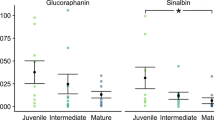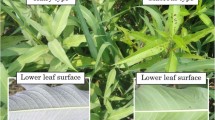Abstract
Based on the accumulation of evidence, the risk of herbivory depends not only on the traits of a plant but also on those of neighboring plants. Despite the potential importance of frequency-dependent interactions in the evolutionary stability of anti-herbivore defense, we know little about such associational effects between defended and undefended plants within a species. In this study, we determined whether the intraspecific associational effects against the oligophagous leaf beetle, Phaedon brassicae, caused a minority advantage in defense and growth between trichome-producing (hairy) and trichomeless (glabrous) plants of Arabidopsis halleri subsp. gemmifera. We experimentally demonstrated that the magnitude of herbivory and the number of adult beetles on hairy plants decreased when hairy plants were a minority, whereas the leaf damage and the beetle abundance did not differ between hairy and glabrous plants when glabrous plants were a minority. By contrast, the larvae of P. brassicae occurred less when hairy plants were a majority. We also found a reciprocal minority advantage in the biomass production for both hairy and glabrous plants. Additionally, the adults tended to attack glabrous leaves more rapidly than hairy ones, particularly when the beetles were starved or experienced glabrous diets. Furthermore, in the absence of herbivory, the growth of hairy plants tended to be slower than glabrous plants, which indicated a cost for the production of trichomes. Our study suggests that associational effects are a mechanism for the maintenance of trichome dimorphism by contributing to negative frequency-dependent growth.



Similar content being viewed by others
References
Agrawal AA, Lau JA, Hambäck PA (2006) Community heterogeneity and the evolution of interactions between plants and insect herbivores. Q Rev Biol 81:349–376
Agresti A (2002) Categorical data analysis, 2nd edn. Wiley, Hoboken
Augner M, Fagerström T, Tuomi J (1991) Competition, defense and games between plants. Behav Ecol Sociobiol 29:231–234
Ayala FJ, Campbell CA (1974) Frequency-dependent selection. Ann Rev Ecol Syst 5:115–138
Barbosa P, Hines J, Kaplan I, Martinson H, Szczepaniec A, Szendrei Z (2009) Associational resistance and associational susceptibility: having right or wrong neighbors. Annu Rev Ecol Evol Syst 40:1–20
Bates D, Maechler M, Bolker B, Walker S (2014) lme4: Linear mixed-effects models using Eigen and S4. R package version 1.1-6. http://CRAN.R-project.org/package=lme4
Bergvall UA, Rautio P, Kesti K, Tuomi J, Leimar O (2006) Associational effects of plant defences in relation to within- and between-patch food choice by a mammalian herbivore: neighbour contrast susceptibility and defence. Oecologia 147:253–260
Brower LP, Pough FH, Meck HR (1970) Theoretical investigations of automimicry, I. Single trial learning. Proc Natl Acad Sci 66:1059–1066
Brunet J, Mundt CC (2000) Disease, frequency-dependent selection, and genetic polymorphisms: experiments with stripe rust and wheat. Evolution 54:406–415
Callaway RM, Kikodze D, Chiboshvili M, Khetsuriani L (2005) Unpalatable plants protect neighbors from grazing and increase plant community diversity. Ecology 86:1856–1862
Christensen RHB (2013) Ordinal—regression models for ordinal data. R package version 2013.9-30 http://www.cran.r-project.org/package=ordinal/
Chu CC, Freeman TP, Buckner JS, Henneberry TJ, Nelson DR, Natwick ET (2001) Susceptibility of upland cotton cultivars to Bemisia tabaci biotype B (Homoptera: Aleyrodidae) in relation to leaf age and trichome density. Ann Entomol Soc Am 94:743–749
Damgaard C (1998) Plant competition experiments: testing hypotheses and estimating the probability of coexistence. Ecology 79:1760–1767
Elle E, van Dam NM, Hare JD (1999) Cost of glandular trichomes, a “resistance” character in Datura wrightii Regel (Solanaceae). Evolution 53:22–35
Gigord LDB, Macnair MR, Smithson A (2001) Negative frequency-dependent selection maintains a dramatic flower color polymorphism in the rewardless orchid Dactylorhiza sambucina (L.) Soò. Proc Natl Acad Sci 98:6253–6255
Grebe M (2012) The patterning of epidermal hairs in Arabidopsis—updated. Curr Opin Plant Biol 15:31–37
Hambäck PA, Inouye BD, Andersson P, Underwood N (2014) Effects of plant neighborhoods on plant-herbivore interactions: resource dilution and associational effects. Ecology 95:1370–1383
Hughes MA (1991) The cyanogenic polymorphism in Trifolium repens L. (white clover). Heredity 66:105–115
Inouye BD (2001) Response surface experimental designs for investigating interspecific competition. Ecology 82:2696–2706
Kawagoe T, Kudoh H (2010) Escape from floral herbivory by early flowering in Arabidopsis halleri subsp. gemmifera. Oecologia 164:713–720
Kawagoe T, Shimizu KK, Kakutani T, Kudoh H (2011) Coexistence of trichome variation in a natural plant population: a combined study using ecological and candidate gene approaches. PLoS One 6:e22184
Kim TN, Underwood N (2015) Plant neighborhood effects on herbivory: damage is both density and frequency dependent. Ecology 96:1431–1437
Kivimäki M, Kärkkäinen K, Gaudeul M, Løe G, Ågren J (2007) Gene, phenotype and function: GLABROUS1 and resistance to herbivory in natural populations of Arabidopsis lyrata. Mol Ecol 16:453–462
Koricheva J (2002) Meta-analysis of sources of variation in fitness costs of plant antiherbivore defenses. Ecology 83:176–190
Kühnle A, Müller C (2012) Prefeeding and acceptance behavior of an oligophagous beetle is dependent on plant suitability and rearing history. J Insect Behav 25:155–165
Nakagawa S (2004) A farewell to Bonferroni: the problems of low statistical power and publication bias. Behav Ecol 15:1044–1045
Ôtake A, Funaki S (1958) The distribution of Phaedon brassicae Baly, with special reference to influences of the dispersal of the adults upon the distribution of their next generation. Bull Shimane Agric Univ 6:107–116 (in Japanese with English summary)
Puentes A, Ågren J (2013) Trichome production and variation in young plant resistance to the specialist insect herbivore Plutella xylostella among natural populations of Arabidopsis lyrata. Entomol Exp Appl 149:166–176
R Core Team (2013) R: a language and environment for statistical computing. R Foundation for Statistical Computing, Vienna, Austria. http://www.R-project.org/
Rautio P, Bergvall UA, Tuomi J, Kesti K, Leimar O (2012) Food selection by herbivores and neighbourhood effects in the evolution of plant defences. Ann Zool Fenn 49:45–57
Rhoades DF (1979) Evolution of plant chemical defense against herbivores. In: Rosenthal GA, Janzen DH (eds) Herbivores: their interaction with secondary plant metabolites. Academic Press, New York, pp 2–54
Root RB (1973) Organization of a plant-arthropod association in simple and diverse habitats: the fauna of collards (Brassica oleracea). Ecol Monogr 43:95–124
Ruppel RF (1983) Cumulative insect-days as an index of crop protection. J Econ Entomol 76:375–377
Sabelis MW, de Jong MC (1988) Should all plants recruit bodyguards? Conditions for a polymorphic ESS of synomone production in plants. Oikos 53:247–252
Sato Y, Kawagoe T, Sawada Y, Hirai MY, Kudoh H (2014) Frequency-dependent herbivory by a leaf beetle, Phaedon brassicae, on hairy and glabrous plants of Arabidopsis halleri subsp. gemmifera. Evol Ecol 28:545–559
Siemens DH, Roy BA (2005) Tests for parasite-mediated frequency-dependent selection in natural populations of an asexual plant species. Evol Ecol 19:321–338
Simms EL, Fritz RS (1992) Costs of plant resistance to herbivory. In: Fritz RS, Simms EL (eds) Plant resistance to herbivores and pathogens: ecology, evolution, and genetics. University of Chicago Press, Chicago, pp 392–425
Sletvold N, Huttunen P, Handley R, Kärkkäinen K, Ågren J (2010) Cost of trichome production and resistance to a specialist insect herbivore in Arabidopsis lyrata. Evol Ecol 24:1307–1319
Speed MP, Ruxton GD (2005) Warning displays in spiny animals: one (more) evolutionary route to aposematism. Evolution 59:2499–2508
Stamp N (2003) Out of the quagmire of plant defense hypotheses. Q Rev Biol 78:23–55
Svennungsen TO, Holen ØH (2007) The evolutionary stability of automimicry. Proc R Soc Lond B 274:2055–2063
Till-Bottraud I, Gouyon PH (1992) Intra-versus interplant Batesian mimicry? A model on cyanogenesis and herbivory in clonal plants. Am Nat 139:509–520
Tuomi J, Augner M, Leimar O (1999) Fitness interactions among plants: optimal defence and evolutionary game theory. In: Vuorisalo TO, Mutikaine PK (eds) Life-history evolution in plants. Kluwer Academic Publishers, Dordrecht, pp 63–84
Underwood N, Inouye BD, Hambäck PA (2014) A conceptual framework for associational effects: when do neighbors matter and how would we know? Q Rev Biol 89:1–19
Wagner GJ, Wang E, Shepherd RW (2004) New approaches for studying and exploiting an old protuberance, the plant trichome. Ann Bot 93:3–11
Wang XP, Zhou XM, Lei CL (2007a) Development, survival and reproduction of the Brassica leaf beetle, Phaedon brassicae Baly (Coleoptera: Chrysomelidae) under different thermal conditions. Pan-Pac Entomol 83:143–151
Wang XP, Zhou XM, Wang YY, Lei CL (2007b) Internal reproductive system and diapausing morphology of the Brassica leaf beetle Phaedon brassicae Baly (Coleoptera: Chrysomelidae: Chrysomelinae). Coleopt Bull 61:457–462
White JA, Whitham TG (2000) Associational susceptibility of cottonwood to a box elder herbivore. Ecology 81:1795–1803
Windsor AJ, Reichelt M, Figuth A, Svatoš A, Kroymann J, Kliebenstein DJ, Gershenzon J, Mitchell-Olds T (2005) Geographic and evolutionary diversification of glucosinolates among near relatives of Arabidopsis thaliana (Brassicaceae). Phytochemistry 66:1321–1333
Wise MJ, Yi CG, Abrahamson WG (2009) Associational resistance, gall-fly preferences, and a stem dimorphism in Solidago altissima. Acta Oecol 35:471–476
Yamawo A, Suzuki N, Tagawa J, Hada Y (2012) Leaf ageing promotes the shift in defence tactics in Mallotus japonicus from direct to indirect defence. J Ecol 100:802–809
Yee TW (2013) VGAM: vector generalized linear and additive models. R package version 0.9-3. http://CRAN.R-project.org/package=VGAM
Züst T, Joseph B, Shimizu KK, Kliebenstein DJ, Turnbull LA (2011) Using knockout mutants to reveal the growth costs of defensive traits. Proc R Soc Lond B 278:2598–2603
Zvereva EL, Kozlov MV, Niemelä P (1998) Effects of leaf pubescence in Salix borealis on host-plant choice and feeding behaviour of the leaf beetle, Melasoma lapponica. Entomol Exp Appl 89:297–303
Acknowledgements
The authors thank Drs. K. Ito and R. Nakadai and three anonymous reviewers for their valuable comments on the manuscript, and Drs. T. Kawagoe and J. Sugisaka for their assistance during the fieldwork. We are also grateful to the Bristol-Kyoto Plant Sciences Workshop for facilitating our discussion. The NEXT program (GS013) and Grant-in-Aid for Scientific Research (S) 26221106, MEXT, to H.K., and the JSPS research fellowship for young scientists (15J00400) and the research assistant fellowship of Kyoto University to Y.S. supported this study. The authors declare no conflicts of interests regarding this study.
Author information
Authors and Affiliations
Corresponding author
Electronic supplementary material
Below is the link to the electronic supplementary material.
Rights and permissions
About this article
Cite this article
Sato, Y., Kudoh, H. Associational effects against a leaf beetle mediate a minority advantage in defense and growth between hairy and glabrous plants. Evol Ecol 30, 137–154 (2016). https://doi.org/10.1007/s10682-015-9809-0
Received:
Accepted:
Published:
Issue Date:
DOI: https://doi.org/10.1007/s10682-015-9809-0




